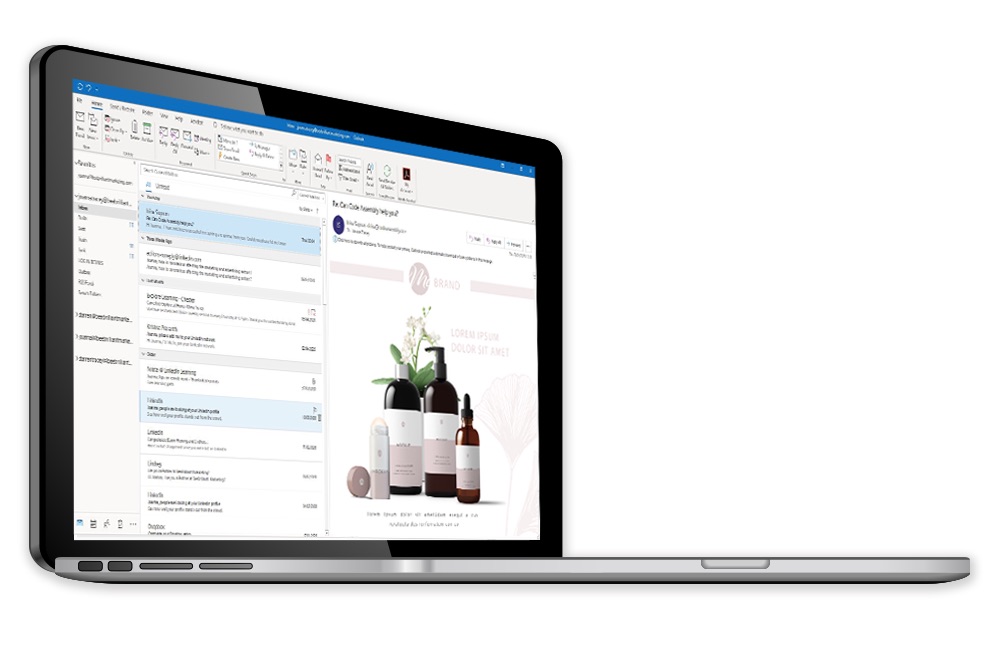Did you know that 79.19% of marketing emails end up in the trash without evening being opened? And that only 2.5% of those who receive them actually click on your link or call to action? Harsh, we know. Email marketing for small business is tough.
That’s why learning how to write an email campaign that converts is vital to a successful marketing strategy. So here are some valuable small business email marketing tips to get you on the winning side of those heartbreaking statistics.
12 email marketing tips…
…to help you write a campaign that converts and doesn’t push your audience to hit ‘unsubscribe’.
1. Write an effective subject line
First things first. You could have the answer to life, the universe, and everything in the body of your email, but… nobody is going to read it if the subject line doesn’t persuade them to. That’s why the majority of newsletters and marketing emails are sent straight to the trash before even clicking onto them.
Without focusing on crafting a compelling subject line you might as well ignore the following eleven email marketing tips!
Your subject line should tell your audience exactly why they should open the email. Before you fall for a boring ‘we’re excited to announce that’ or ‘an update from [your company name]’, remember this: unless you’re the celebrity that they’ve been crushing on for years, we’re afraid that nobody reads your emails because they care about you. They only care about what brings value to them. Does your subject promise that value to them or not?
The trick is to combine marketing and psychology by crafting a subject line that triggers their fear of missing out (#FOMO), excites them by giving them a compelling reason to open it, or clearly states the benefits that they will receive if they do.
Use actionable language (e.g. ‘Treat your loved one to a dinner on us, this weekend’), emojis if they’re consistent with your brand tone, and consider personalising it by adding their first name. This makes it 26% more likely to avoid the terrible sent-to-the-bin-without-opening-it scenario.
Whatever you do, don’t make your subject line too long or it’ll be automatically cut at a random point! Although 41 characters seems to be the most effective length for a good open rate, keep in mind that most mobiles will cut them at 30 characters.
2. Trial alternative subject lines with different people
Given the importance of subject lines, it’s a wise idea to experiment with a couple of options by sending ‘subject line A’ to a portion of your subscribers and ‘subject line B’ to the rest. Once your campaign is over, you can run some analytics to see which performed better.
This will give you a deeper insight into your target audience’s preferences and what seems to resonate—and work—the most with them. That way you’ll be even more prepared for your next campaign!
3. Don’t forget about the preview text
Not as powerful as your subject line, but still another potential game-changer. Your subject line’s sidekick, we could say. The Sam to its Frodo. But, let’s be honest: where would Frodo be without him?
Don’t you dare forget about the preview text that appears on the right side of the subject line, because it’s like meta descriptions: if you don’t add them, they’ll be automatically generated for you. This could either result in the first line of your email or—worse—a standard message like ‘View this email in your web browser’. How exciting, right? (Not.)
It’s another free chance to grab your leads’ attention and convince them to open the email: why would you want to waste it?
You’ve got a few characters to play with (the recommended length is between 35 and 140): make them count. The most effective trick is to genuinely think of your preview text in relation to the subject line: is it simply repeating it or is it complementing it? Does it help you convey the benefits that your reader will get if they open this email or not really?

4. Have a familiar ‘from’ name
This might sound obvious, but you’d be surprised at how easy it is to overlook this step. Have you ever received an email from a company whose updates you’ve actually subscribed to, but found yourself wondering who on earth that was when you looked at the sender’s name? Make sure that yours is instantly recognisable.
5. Have a clear layout and design
Now that you’ve taken care of these steps, you can start thinking of the actual email. Get ready though: once a user opens it, the countdown starts.
Don’t forget that we live in an age of 8-second attention spans: not only should your content convey its importance and main message in less than that (more about this in the next tip), but the overall look and feel of your email should immediately make the reader feel comfortable and at ease.
Whether you’re using a template or traditional text, it shouldn’t put them off immediately. Contrasting colours and a template that’s hard to read? A huge body of text that isn’t broken into paragraphs? A template that isn’t mobile responsive and forces them to enlarge the screen to make that tiny text readable? No, no, NOPE.
Basically, you should treat your email like you would a web page or a blog post: make it clear, immediate, and pleasant to look at.
6. Write a clear and compelling body
There’s really no time for rambling. It’s important to create a clear structure rather than jump from one point to another or repeat yourself.
Your email should get straight to the point as soon as possible before you lose your reader’s attention: instead of promoting features, emphasise the benefits that your readers will unlock if they follow through with your call to action.
7. Write for your target audience and be relevant to them
You must think of your email campaigns as part of your content marketing strategy, not a different form of ads: they should bring value to the readers or, better, allow them to find something that brings them value by following your call to action.
That’s why it’s vital to write these emails with your target audience in mind. Don’t try to please everyone, because it never works: you actually end up appealing to nobody.
Remember their characteristics (e.g. age, lifestyle, interests, etc.) so that you can tell them something that they actually care about and, most importantly, in a way that they’ll appreciate.
And make sure you talk to them directly: use the second person and their first name rather than a generic ‘Dear readers’.
8. Optimise it for one call to action
Do you remember when, as a kid, your mum asked you to help out with the chores and you ended up… not doing anything? But then if she specifically asked you to do the washing up you might actually do it? Same with emails.
Being vague or confusing your readers with multiple calls to actions won’t work. If you’re not clear about what they should do next, they won’t do it. So, be specific! Don’t confuse them with lots of potential actions: you’re writing an email, not a choose-your-own-adventure book.
To strive for a higher click-through rate, optimise its entire body for a specific call to action and have a clickable button that reinforces it (e.g. ‘Grab your tickets’, or ‘Secure your spot today’). Not a plan, generic ‘Click here’.
We know you can do better than that.
Not sure how to write an email marketing campaign for your small business?
Speak to our email marketing experts today and start converting clients tomorrow!
9. Avoid the spam filter
As well as poor subject lines, there’s another reason why your email could end up in the trash without being seen: if it’s deemed as spam. That way, it won’t even reach your potential customers’ inboxes!
To try your best to avoid this dangerous scenario, refrain yourself from repeating words like ‘free’ or ‘click here’ too many times. Even better, check your email provider’s blacklisted words (they can change over time!).
OH, AND WRITING IN ALL CAPS LIKE THIS AS IF YOU WERE SHOUTING? That’s another safe ticket to the spam folder.
10. Complement it with media
Once you’ve got all the right words, you can think of other media, if needed. It might be that your campaign works perfectly as a text-only email, but, if you feel that particular images or videos could help you make it even more compelling… go for it.
After all, 65% of users prefer emails that contain lots of images. The general rule is to make sure it all feels cohesive and aligned. Don’t use heavy images, though, or else it will take too long to load!
11. Stay GDPR compliant
Some marketers and businesses go for shady (and now illegal) practices such as buying third-party email lists. We’re sure you wouldn’t do that: we can tell you’re one of the good ones and that you only send your emails to those who’ve genuinely opted in!
But, if you’re worried as to how to write an email campaign that is fully compliant with GDPR, make sure that you make it quick and easy for your readers to opt out and unsubscribe.
12. Run tests to know what works best for your audience
Finally, to ensure the best possible results and set yourself up for success when it comes to upcoming campaigns, do what you did with your subject line: send different emails (for the same campaign) to separate portions of your subscribers’ list.
Once you figure out what performed better and what didn’t really work it’ll be much easier to plan the next campaign. It’s all about what your target audience likes the most!
Now that you’ve learned how to write an email campaign that converts and feels relevant to your audience, you’ll also be able to build a stronger relationship with them rather than push them to hit the unsubscribe button. Double win.
Don’t want to run any risks? Let us take care of your small business email marketing campaigns! After all, that’s what we’re good at.
Check out our email marketing services.
 Joanna Tracey
Joanna Tracey